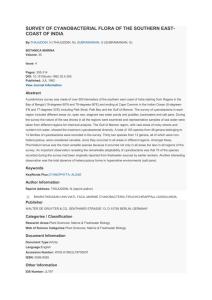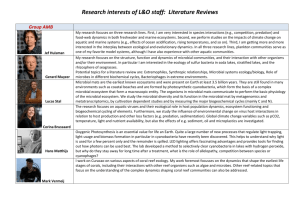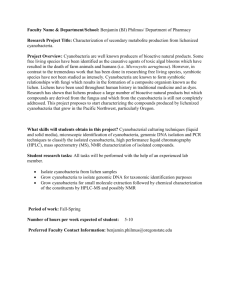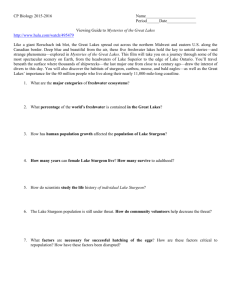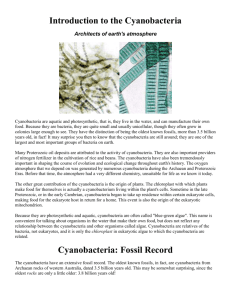Comparative analysis of microbial communities in two freshwater
advertisement
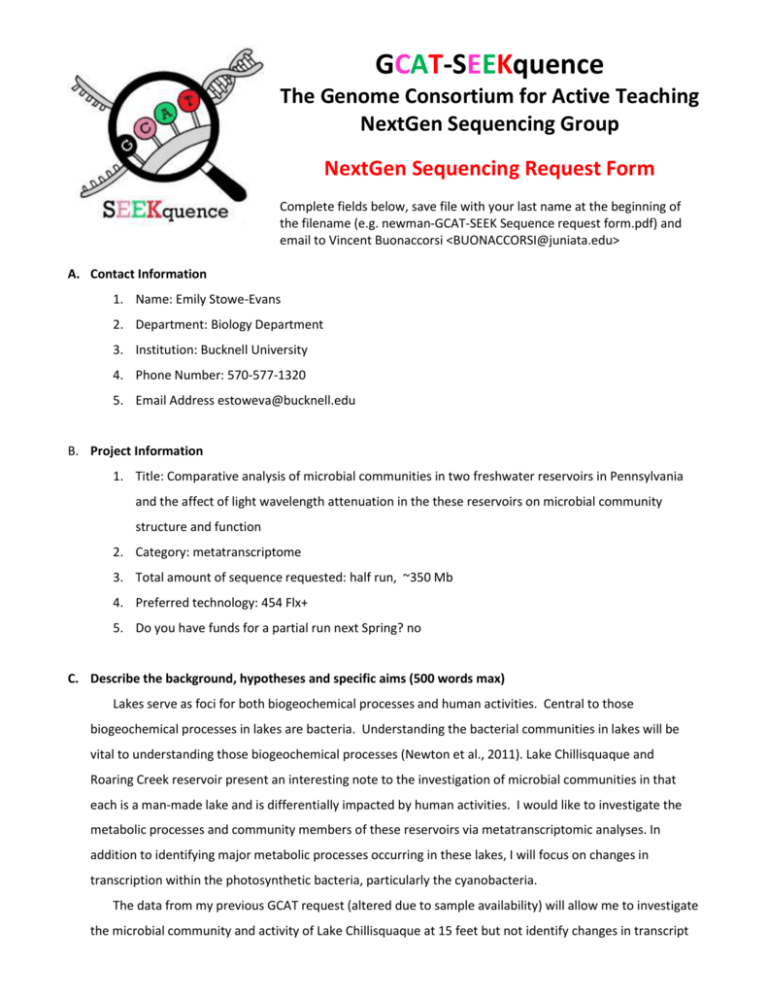
GCAT-SEEKquence The Genome Consortium for Active Teaching NextGen Sequencing Group NextGen Sequencing Request Form Complete fields below, save file with your last name at the beginning of the filename (e.g. newman-GCAT-SEEK Sequence request form.pdf) and email to Vincent Buonaccorsi <BUONACCORSI@juniata.edu> A. Contact Information 1. Name: Emily Stowe-Evans 2. Department: Biology Department 3. Institution: Bucknell University 4. Phone Number: 570-577-1320 5. Email Address estoweva@bucknell.edu B. Project Information 1. Title: Comparative analysis of microbial communities in two freshwater reservoirs in Pennsylvania and the affect of light wavelength attenuation in the these reservoirs on microbial community structure and function 2. Category: metatranscriptome 3. Total amount of sequence requested: half run, ~350 Mb 4. Preferred technology: 454 Flx+ 5. Do you have funds for a partial run next Spring? no C. Describe the background, hypotheses and specific aims (500 words max) Lakes serve as foci for both biogeochemical processes and human activities. Central to those biogeochemical processes in lakes are bacteria. Understanding the bacterial communities in lakes will be vital to understanding those biogeochemical processes (Newton et al., 2011). Lake Chillisquaque and Roaring Creek reservoir present an interesting note to the investigation of microbial communities in that each is a man-made lake and is differentially impacted by human activities. I would like to investigate the metabolic processes and community members of these reservoirs via metatranscriptomic analyses. In addition to identifying major metabolic processes occurring in these lakes, I will focus on changes in transcription within the photosynthetic bacteria, particularly the cyanobacteria. The data from my previous GCAT request (altered due to sample availability) will allow me to investigate the microbial community and activity of Lake Chillisquaque at 15 feet but not identify changes in transcript abundance from cyanobacteria that altered with changes in the light wavelength abundance from surface to depth. My original questions remains, however, how does the attenuation of light through freshwater affect the physiological processes of the lake inhabitants? My most focused question is on the use of light as a developmental cue in cyanobacteria. Many species of cyanobacteria use specific wavelengths of light to direct the construction of their light harvesting antennae in a process called chromatic adaptation. Previous studies indicated 1) chromatically adapting cyanobacteria are prevalent in marine systems at depths where RL becomes limiting and where light conditions fluctuate, and 2) that in direct competition with nonadapting species, the chromatically adapting species will alter the PBS composition via changes in gene transcription, to absorb wavelengths of light not used by the non-adapting species. No studies to date have looked at chromatic adaption as it occurs in real time. Chromatic adaptation has also not been well studied in small freshwater lakes. Even in small freshwater lakes as light penetrates water, specific wavelengths become differentially abundant. Through a combination of scattering and absorption red light becomes less abundant with depth, thus with increased depth, the light available to photosynthetic organisms becomes enriched in the shorter green wavelengths. The gradation of available wavelengths may limit non-adapting cyanobacteria to certain locations within the water column, but adapting species will not be limited in their niche selection and will instead alter transcriptional patterns depending on their location within the water column. I hypothesize that differential abundance of specific wavelengths within a water column has an influence on both community membership and activity as measured by changes in gene transcription and community composition. My previous research has indicated that the microbial populations of Lake Chillisquaque and Roaring Creek are diverse (greater than 30 different operational taxonomic unit) and that they contain cyanobacteria capable of chromatic adaptation. However, PCR based community analysis has shown primer bias, as certain classes of cyanobacteria are visible by microscopy but have not been identified molecularly. A metatranscriptomic analysis will allow me to identify members of the community via rRNA analysis and their activity through transcript analysis. D. Describe the methods [sample prep, calculation of amount of sequence required, analysis plan] I propose to use a metatranscriptomic approach to continue to assess the community membership and activity as it is affected by light in the Roaring Creek reservoir and Lake Chillisquaque. From each lake, I will collect water samples from the surface and from approximately 5 meters below the surface, at which point my previous measurements indicate available RL is greatly reduced compared to available GL. The earliest I have access to the lakes is May (restrictions due to waterfowl migratory patterns) and so will collect samples in June 2012. Therefore I will have a total of four samples. I am requesting one eighth of a slide for 454 Flx sequencing for each sample, thus one half of a total run for the experiment. This should generate approximately 125,000 reads per sample and approximately 62.5 MB of sequence per sample. Total RNA will be isolated using the MoBIO Powerwater RNA extraction kit. One microgram of DNase treated RNA from each sample will be sent to PSU. I am specifically not removing the rRNA or amplifying the mRNA as per a previous study (Urich et al, 2008). I would like to use the rRNA sequencing to analyze community membership and the mRNA to analyze community function. I will begin by identifying the transcripts associated with cyanobacterial photosynthetic processes. I expect to see an increase in the expression of GL induced genes from the chromatically adapting species with increased depth. This study will produce a data set including a large amount of information not related to chromatic adaptation. However, this data will be extremely useful to understanding the role light plays in structuring the community of other photosynthetic bacteria as well as cyanobacteria. My own undergraduate research students and myself, relying on the programs available at Galaxy and Megan4 analytical pipeline developed by Dr. Steven Schuster and others (Huson et al., 2011), will conduct the primary data analyses. Environmental RNA would be ready for shipping to PSU by October 2012. E. Describe the role and number of undergraduates involved in the project, and how they would benefit. My undergraduate research students will be involved in data analysis (~4). Additionally, in the Fall of 2013 I will teach a Functional Genomics course and the data provided from this project will provide a source of training material for those students (~16). My colleague Brian King, in computer science, has indicated that he would find such a data set useful in developing real world labs for his computer science classes. Additionally, my previous studies have indicated a diverse population of non-photosynthetic bacteria. I hope that in conjunction with on-going studies run by the Bucknell Environmental Center, which maintains a research center at Roaring Creek reservoir, we will be able to map transcriptional changes between the surface and depth with other physical characteristics of the reservoir. F. I agree to administer the GCAT-SEEK pre- and post-activity assessment test for students and to complete the faculty post-utilization survey. ___x_ yes, ____ no G. Describe any other broader impact or intellectual merit considerations. This project will allow continued collaboration between the Computer Science Department and Biology Department at Bucknell. To date there have been no studies published attempting to measure transcriptional changes due to changes in light availability in a small freshwater lake. H. References Huson, DH., S. Mitra, H-J. Rusheweyh, N. Weber and S. Schuster. (2011). Integrative analysis of environmental sequences using MEGAN4. Genome Research. 21: 1552-1560. Newton, R. J., S. E. Jones, A. Eiler, K. D. McMahon and S. Bertilsson. (2011). A Guide to the Natural Hisotry of Freshwater Bacteria. MMB Reviews 75 (1): 14-49. Urich, T., A. Lanzen, J. Qi, D. Huson, C. Schleper, S. Schuster. (2008). Simultaneous assessment of soil microbial community structure and function through analysis of the meta-transcriptome. PLoS ONE 3(6): e2527.
